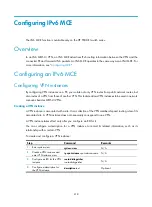
424
Step Command
Remarks
4.
Specify an IPv6 BGP peer in
an AS.
peer
ipv6-address
as-number
as-number
N/A
5.
Redistribute remote site routes
advertised by the PE.
import-route
protocol
[
process-id
[
med
med-value
|
route-policy
route-policy-name
] * ]
By default, No route redistribution
is configured.
6.
Configure a filtering policy to
filter the routes to be
advertised.
filter-policy
{
acl6-number
|
ipv6-prefix
ip-prefix-name
}
export
[
direct
|
isisv6
process-id
|
ripng
process-id
|
static
]
Optional.
By default, the IPv6 MCE does not
filter the routes to be advertised.
7.
Configure a filtering policy to
filter the received routes.
filter-policy
{
acl6-number
|
ipv6-prefix
ip-prefix-name
}
import
Optional.
By default, the IPv6 MCE does not
filter the received routes.
NOTE:
After you configure an IPv6 BGP VPN instance, the IPv6 BGP route exchange for the IPv6 VPN instance is
the same with the normal IPv6 BGP VPN route exchange. For more information about IPv6 BGP, see
Layer
3—IP Routing Configuration Guide.
2.
Configure a VPN site:
Step Command
Remarks
1.
Enter system view.
system-view
N/A
2.
Enter BGP view.
bgp
as-number
N/A
3.
Enter IPv6 address family
view.
ipv6-family
N/A
4.
Configure the IPv6 MCE as
the EBGP peer.
peer
ipv6-address
as-number
as-number
N/A
5.
Redistribute the IGP routes of
the VPN.
import-route
protocol
[
process-id
[
med
med-value
|
route-policy
route-policy-name
] * ]
Optional.
By default, no route redistribution
is configured.
A VPN site must advertise the IPv6
VPN network addresses it can
reach to the connected IPv6 MCE.
Configuring routing between IPv6 MCE and PE
IPv6 MCE-PE routing configuration includes these tasks:
•
Bind the IPv6 MCE-PE interfaces to IPv6 VPN instances
•
Perform routing configurations
•
Redistribute IPv6 VPN routes into the routing protocol running between the IPv6 MCE and the PE.
Configuring IPv6 static routing between IPv6 MCE and PE
To configure IPv6 static routing between IPv6 MCE and PE:
















































